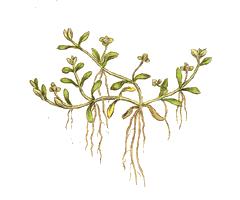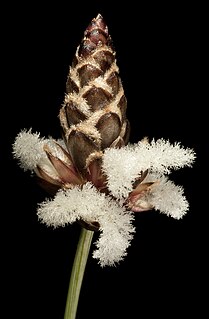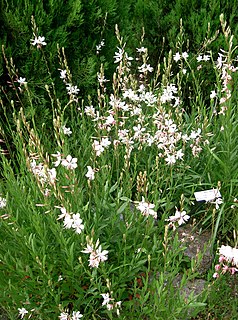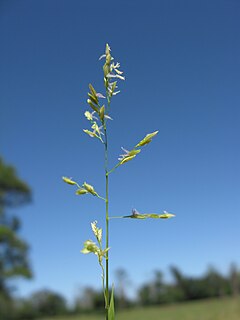
Banksia is a genus of around 170 species in the plant family Proteaceae. These Australian wildflowers and popular garden plants are easily recognised by their characteristic flower spikes, and fruiting "cones" and heads. Banksias range in size from prostrate woody shrubs to trees up to 30 metres tall. They are found in a wide variety of landscapes: sclerophyll forest, (occasionally) rainforest, shrubland, and some more arid landscapes, though not in Australia's deserts.

Manilkara is a genus of trees in the family Sapotaceae. They are widespread in tropical and semitropical locations, in Africa, Madagascar, Asia, Australia, and Latin America, as well as various islands in the Pacific and in the Caribbean. A close relative is the genus Pouteria.

Elatinaceae is a family of flowering plants with ca 35 species in two genera: Elatine and Bergia. The Elatine are mostly aquatic herbs, and the Bergia are subshrubs to shrubs. Elatine species are widely distributed throughout the world from temperate to tropical zones, with its greatest diversity found in temperate zones. Bergia is found in temperate to tropical Eurasia and Africa, with two tropical and one tropical to temperate species in the Americas. The center for biodiversity of Bergia is the Old World tropics, and this is also the center for biodiversity for the family. Neither genus is found in arctic ecosystems.

Dodonaea is a genus of about 70 species of flowering plants, often known as hop-bushes, in the soapberry family, Sapindaceae. It has a cosmopolitan distribution in tropical, subtropical and warm temperate regions of Africa, the Americas, southern Asia and Australasia. By far the highest species diversity is in Australia. The genus is named after Rembert Dodoens, traditionally known as 'Dodonaeus'.

The Ecdeiocoleaceae comprise a family of flowering plants with two genera and three species. The botanical name has rarely been recognized by taxonomists.

Thryptomene is a genus of flowering plants in the family Myrtaceae and is endemic to Australia. Plants in the genus Thryptomene are shrubs with small leaves arranged in opposite pairs and white or pink flowers. About forty-seven species of Thryptomene, occurring in all Australian states and the Northern Territory, have been formally described.

Gaura is a genus of flowering plants in the family Onagraceae, native to North America. The genus includes many species known commonly as beeblossoms. Recent genetic research has shown that the genus is paraphyletic unless the monotypic genus Stenosiphon is included within Gaura, increasing the number of species in the genus to 22.

Vancouveria is a small group of plants belonging to the barberry family described as a genus in 1834. The three plants in this genus are known generally as inside-out flowers, and they are endemic to the West Coast of the United States. The genus was named after George Vancouver, English navigator and explorer.
- Vancouveria chrysanthaGreene – golden inside-out flower – California, Oregon
- Vancouveria hexandra(Hook.) C.Morren & Decne. – white inside-out flower – northwestern California, western Oregon, southwestern Washington
- Vancouveria planipetalaCalloni – redwood inside-out flower – California as far south as Monterey County, southwestern Oregon

Ladenbergia is a genus of plant in the family Rubiaceae. It contains the following species :

Haloragis is a genus of flowering plants in the family Haloragaceae. Some species are known commonly as seaberry and most are native to the southern hemisphere. They are annual or perennial herbs to small shrubs, and many are terrestrial wetland plants.

Thryptomene hexandra, commonly known as Palm Valley myrtle in the Northern Territory, is a species of flowering plant in the family Myrtaceae and is endemic to north-eastern Australia. It is an erect, much-branched shrub with linear to lance-shaped leaves and white flowers with six stamens.

Leersia is a genus of plants in the grass family which includes species known generally as cutgrasses.

Manilkara hexandra is a tree species in the tribe Sapoteae, in the family Sapotaceae. It is native to much of south Asia (China: Hainan and southern Guangxi provinces; the Indian subcontinent: Bangladesh, India, and Sri Lanka; Indo-China: Cambodia, Myanmar, Thailand and Vietnam. Its vernacular names vary regionally; for example "Palu", "Palai" in Tamil or "Rayan" in Sinhalese. It is locally known as the Khirni tree in parts of Bangladesh and India. In the Tamil language it is called Ulakkaippaalai or Kanuppaalai.

Vancouveria hexandra, the white inside-out flower, is a perennial herb in the barberry family Berberidaceae. It is found in southwestern British Columbia, western Washington and Oregon and northwestern California and is a common understory herb in moist, shady Douglas fir forests.

Arrhenes marnas, the affinis skipper or swamp darter, is a butterfly of the family Hesperiidae. The species was described by Felder in 1860. It is found from Queensland to Papua.

Portlandia is a genus of flowering plants in the coffee family, Rubiaceae. Members of the genus are endemic to Jamaica.

Blyxa is a genus of an aquatic plant of the family Hydrocharitaceae described as a genus in 1806.

Leersia hexandra is a species of grass known by the common names southern cutgrass, clubhead cutgrass, and swamp rice grass. It has a pantropical distribution. It is also an introduced species in many regions, sometimes becoming invasive, and it is an agricultural weed of various crops, especially rice. It is also cultivated as a forage for livestock.
Appertiella is a genus of an aquatic plant of the family Hydrocharitaceae described as a genus in 1982. There is only one known species, Appertiella hexandra, endemic to Madagascar.
Hibbertia hexandra, commonly known as tree guinea flower, is a species of flowering plant in the family Dilleniaceae and is endemic to eastern Australia. It is a tall shrub or small tree with mostly lance-shaped leaves with the narrower end towards the base and yellow flowers arranged singly in leaf axils, with six stamens arranged around two hairy carpels.


















